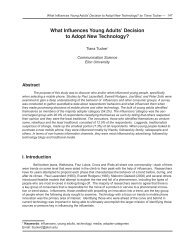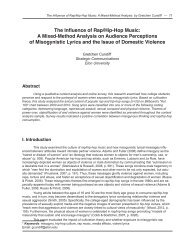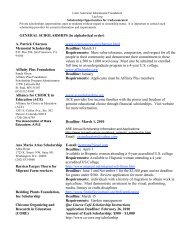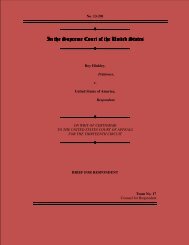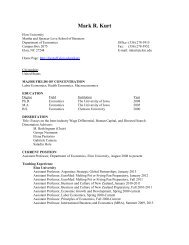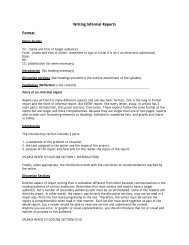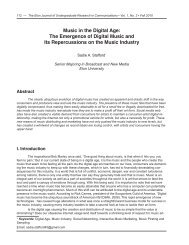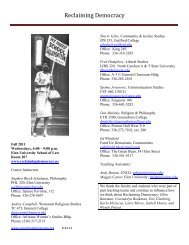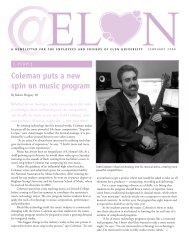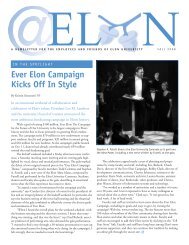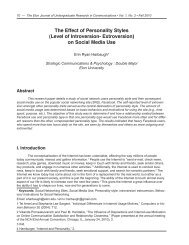Is Generation Y Addicted to Social Media? - Elon University
Is Generation Y Addicted to Social Media? - Elon University
Is Generation Y Addicted to Social Media? - Elon University
You also want an ePaper? Increase the reach of your titles
YUMPU automatically turns print PDFs into web optimized ePapers that Google loves.
Abstract<br />
<strong>Is</strong> <strong>Generation</strong> Y <strong>Addicted</strong> <strong>to</strong> <strong>Social</strong> <strong>Media</strong> by Jaclyn Cabral — 5<br />
<strong>Is</strong> <strong>Generation</strong> Y <strong>Addicted</strong> <strong>to</strong> <strong>Social</strong> <strong>Media</strong>?<br />
Jaclyn Cabral<br />
Strategic Communications<br />
<strong>Elon</strong> <strong>University</strong><br />
This study examined <strong>Generation</strong> Y’s psychological addiction <strong>to</strong> social media with specific regard <strong>to</strong><br />
Facebook, MySpace, Twitter and LinkedIn. The addiction was interpreted using Griffiths’ six components that<br />
determine behavioral addiction: salience, mood modification, <strong>to</strong>lerance, withdrawal, conflict and relapse. The<br />
purpose of this study was <strong>to</strong> determine if <strong>Generation</strong> Y was in fact addicted <strong>to</strong> social media because of their<br />
need <strong>to</strong> maintain relationships with their peers. The results indicated that this sample of <strong>Generation</strong> Y suffers<br />
from three components, <strong>to</strong>lerance, salience and relapse. They also suffers from intrapsychic conflict, but not<br />
interpersonal conflict.<br />
I. Introduction<br />
The Internet has an indescribable power <strong>to</strong> influence, connect, and mobilize the current population.<br />
Technological advances are no longer shocking but simply expected. Today’s society has different expectations<br />
for all types of relationships. Relationships are now different because the <strong>to</strong>ols used <strong>to</strong> maintain peer<strong>to</strong>-peer<br />
connections have undergone a vast alteration. The primary focus is on the Internet and, with that, the<br />
development of social media. <strong>Social</strong> media is a web-based technology that transforms how people communicate<br />
by enhancing interactive conversations. Andreas Kaplan and Michael Haenlein define social media as “a<br />
group of Internet-based applications that build on the ideological and technological foundations of Web 2.0,<br />
which allows the creation and exchange of user-generated content.” 1 <strong>Social</strong> <strong>Media</strong> is a web-based product<br />
that is optimized solely by the use of its public. The only way social media can expand depends exclusively<br />
on the user and their wants.<br />
Mark Zuckerberg, the founder of the world phenomenon Facebook, said, “More than 175 million people<br />
use Facebook. If it were a country, it would be the sixth most populated country in the world.” Facebook<br />
has the ability <strong>to</strong> bring people <strong>to</strong>gether in a wide variety of relationships. A major fac<strong>to</strong>r contributing <strong>to</strong> the high<br />
usability of social media is that it connects people without any boundaries. <strong>Social</strong> media is basically a template<br />
for the user who can then personalize the source’s uses and productivity. It is a highly dense and vast<br />
resource that is being used on a consistent basis <strong>to</strong> maintain relationships. People are now accessing social<br />
media from mobile devices and lap<strong>to</strong>ps making it a commonality in everyday life. Facebook’s indescribable<br />
popularity is one aspect of this interactive world’s power <strong>to</strong> alter the tangible world.<br />
<strong>Social</strong> media is continuing <strong>to</strong> grow exponentially based on the wants of the user. The highest per-<br />
* Keywords: social media, addiction, <strong>Generation</strong> Y, social networking sites, college students’ use of social<br />
media<br />
Email: jcabral@elon.edu<br />
1 Andreas M. Kaplan, Michael Haenlein, Users of the world, unite! The Challenges and Opportunities of <strong>Social</strong><br />
<strong>Media</strong> (Business Horizons, 2010), 59–68.
6 — The <strong>Elon</strong> Journal of Undergraduate Research in Communications • Vol. 2, No. 1 • Spring 2011<br />
centage of social media users are <strong>Generation</strong> Y, also referred <strong>to</strong> as the ‘net generation,’ who have grown up<br />
understanding the power of the Internet. <strong>Generation</strong> Y is unconsciously addicted <strong>to</strong> social media and as a<br />
result they feel constant societal pressure <strong>to</strong> be connected with their peers through maintaining a continuous<br />
connection with technology. Their connectedness is creating new kinds of peer-<strong>to</strong>-peer relationships that are<br />
considerably different from previous generations.<br />
II. Literature Review<br />
The new digital age has brought about extraordinary developments in technology that has altered the<br />
way many people access and use information. The consistent technological developments that help connect<br />
the world can be seen as either beneficial or detrimental <strong>to</strong> human relationships. The World Wide Web is altering<br />
human social interaction and the way the brain processes information. Consequently, scholars dive in<strong>to</strong><br />
the potential of Internet addiction and the Internet’s effect on other behavioral changes. Through reviewing<br />
basic demographics along with psychological and behavioral implications, scholars remain <strong>to</strong>rn on whether<br />
Internet addiction exists but ultimately agree that the new digital age does influence the development of the<br />
human mind.<br />
The first step <strong>to</strong> identifying Internet addiction is <strong>to</strong> see where the emotional and mental attachment<br />
lie. Researchers conclude that there are classic mass media motivations: surveillance; escape, companionship,<br />
and identity; and entertainment. 2 Gordon narrows down this information by concluding that there are<br />
five specific types of use: meeting people, information seeking, distraction, coping and e-mail. 3 When these<br />
concepts are isolated <strong>to</strong> <strong>Generation</strong> Y, Subrahmanya proved that adolescents primarily use the Internet as<br />
a communication <strong>to</strong>ol <strong>to</strong> reinforce relationships. The changes in relationships are exceptionally present in<br />
teens that use instant messaging as a substitute for face-<strong>to</strong>-face conversation with friends. 4 Scholars explain<br />
this phenomenon by discovering that using computer networks for social interaction relieves many aspects of<br />
group anxiety. 5 The infinite possibilities of the web help define alternative realities where anonymity is welcomed<br />
and potentially psychologically rewarding. 6 Scholars agree that the rapid growth of these alternative<br />
realities is beneficial. The ambiguity of social network profiles allows adolescents <strong>to</strong> create an identity and<br />
find social acceptability without having <strong>to</strong> directly face scrutiny. 7 College students are exposed <strong>to</strong> a higher risk<br />
of Internet addiction because of their vulnerability. College students, in particular, are adjusting <strong>to</strong> massive<br />
amounts of developmental and life changes. 8 This susceptibility and exposure <strong>to</strong> an abundance of new things<br />
are aided by the use of technology and social networks that ease new connections and relieve societal pressures.<br />
Researchers have a unanimous decision about the type of gender specific activities adolescents<br />
are using on the web. Gordon, Small, Griffiths, and Lam all agree that males have increased odds of acquiring<br />
an Internet addiction. 9 Men tend <strong>to</strong> use the Internet more often per week and for longer sitting periods<br />
than females. As Gordon explains, men tend <strong>to</strong> be online in order <strong>to</strong> e-mail friends, listen <strong>to</strong> music, get help<br />
with schoolwork, IM, and talk with friends. In contrast, females use the web <strong>to</strong> e-mail friends, get help with<br />
2 Robert Larose, Dana Mastro and Matthew Eastin, “Understanding Internet Usage: A <strong>Social</strong>-Cognitive Approach<br />
<strong>to</strong> Uses and Gratifications,” <strong>Social</strong> Science Computer Review 19 (2001): 396; Lawrence Lam, “Fac<strong>to</strong>rs<br />
Associated with Internet Addiction Among Adolescents,” CyberPsychology & Behavior 12 (2009): 552.<br />
3 Cherly Gordon, Linda Juang, and Moin Syed, “Internet Use and Well-being Among College Students: Beyond<br />
Frequency of Use,” Journal of College Student Development 48 (2007).<br />
4Kaveri Subrahmanya, and Patricia Greenfield, “Online Communication and Adolescent Relationships,” The<br />
Future of Children 18, (2008): 125.<br />
5 Subrahmanya, “Online Communication and Adolescent Relationships,”126; Mark Griffiths, “Does Internet<br />
and Computer “addiction” exist? Some Case Study Evidence,” CyberPsychology & Behavior 3 (2000): 216.<br />
6 Griffiths, “Does Internet and Computer ‘addiction’ exist?” 217.<br />
7 Jennifer Czincz, and Regina Hechanova, “Internet Addiction: Debating the Diagnosis.” Journal of Technology<br />
in Human Services 27 (2009): 262.<br />
8 Cherly Gordon, “Internet Use and Well-being Among College Students.”<br />
9 Cherly Gordon, “Internet Use and Well-being Among College Students”; Gary Small and Gigi Vorgan,<br />
iBrain: Surviving the Technological Alteration of the Modern Mind (Brattleboro: Harper Paperbacks, 2009, 92;<br />
Griffiths, “Does Internet and Computer ‘addiction’ exist?”212; Lam, “Fac<strong>to</strong>rs Associated with Internet Addiction<br />
Among Adolescents,” 553.
<strong>Is</strong> <strong>Generation</strong> Y <strong>Addicted</strong> <strong>to</strong> <strong>Social</strong> <strong>Media</strong> by Jaclyn Cabral — 7<br />
schoolwork, talk with friends, e-mail family and IM. 10 Overall females use the Internet for social networking<br />
and reinforcing pre-existing relationships whereas males use the social networking sites <strong>to</strong> flirt and make new<br />
friends. 11 Males appear more focused on discovering new things whereas females remain confident in what<br />
they already know. In contrast <strong>to</strong> these ideas, researcher Vorgan, through a Pew Internet & American Life<br />
Project, found that women have increased levels of Internet use over the past two decades. Men appear <strong>to</strong><br />
be more tech savvy, seek confidence in search engines, and are more likely <strong>to</strong> try new software and gadgets.<br />
However, over the years these ideas have become cus<strong>to</strong>mary for both genders. 12 Based on this research,<br />
one is able <strong>to</strong> distinguish the typical male Internet user. These males describe themselves as having little <strong>to</strong><br />
no social life without any self-confidence. For these Internet-addicted males, the computer is used <strong>to</strong> counteract<br />
a lack of friends, unattractive physical appearance, or noticeable disability. 13 Overall, men are using the<br />
Internet <strong>to</strong> compensate for insecurities whereas women are reinforcing their tangible relationships.<br />
A majority of research focuses on the true aspects of addiction and assess whether Internet addiction<br />
actually exists. One theory is that web addicts have underlying depression, anxiety, or obsessive-compulsive<br />
disorder. 14 Lam discovers that the experience of a recent high-stress event is related directly <strong>to</strong> Internet addiction.<br />
In this circumstance, the usage of Internet becomes a coping mechanism for stress. He also categorizes<br />
Internet addiction in<strong>to</strong> the spectrum of impulse-control disorders. 15 Many scholars agree on the concept that<br />
addiction is related <strong>to</strong> impulse-control disorders through variations of delayed rewards testing. 16 Those scholars<br />
see a connection between impulse-control disorders and Internet addiction but there is still no tangible<br />
proof that Internet addiction exists. A similar argument, which has strong research behind it, is the connection<br />
of the new digital age and the growth of Attention Deficit Disorder.<br />
Some behavioral consequences of the new digital brain are hyperactivity, inattention, depression and<br />
multitasking mania. Based upon research for brain development, there is a conclusion stating that daily exposure<br />
<strong>to</strong> high technology stimulates brain alternation and neurotransmitter release; ultimately strengthening<br />
new pathways in the brain. The human mind is now learning <strong>to</strong> access and process information more rapidly<br />
and shift attention quickly from one task <strong>to</strong> the next. All this access and vast selection is causing some<br />
entertainment seeker’s brains <strong>to</strong> develop the constant need for instant gratification with a loss of patience.<br />
Technological developments directly affect those who cannot multitask or work with the demands of modern<br />
technology, resulting in symp<strong>to</strong>ms of ADD or ADHD. 17 To narrow down the connection between ADD and the<br />
Internet, Yen discovers that being easily bored rather than easily distracted is the core symp<strong>to</strong>m of inattentive<br />
ADHD. Internet activities are based highly upon their interactivity levels and immediate response rates; these<br />
quick actions relive the feeling of boredom and possibly create a physical addiction. 18 The Internet becomes<br />
the cure for those who cannot hold focus. Once again, research concludes that male college students are<br />
more likely <strong>to</strong> be screened positively for adult ADHD; however, the overall association between Internet addiction<br />
and attention deficit is more significant in females. 19 The fast-paced lifestyle created by the Internet<br />
affects the way the human brain processes and receives information. Humans are now more anxious and<br />
their attention span is weakened by the over stimulation from technology.<br />
Researchers have made conclusions regarding Internet addiction, gender specific activities, and<br />
analyzed behavioral changes; however, large gaps of research remain. These studies are broad, vary upon<br />
method, and focus on the bigger picture. Research involving the vast space of the Internet needs <strong>to</strong> be<br />
10 Cherly Gordon, “Internet Use and Well-being Among College Students.”<br />
11Subrahmanya, “Online Communication and Adolescent Relationships,” 125.<br />
12Gary Small iBrain, 92.<br />
13 Griffiths, “Does Internet and Computer ‘addiction’ exist?” 216.<br />
14 Small, iBrain, 64.<br />
15 Lam, “Fac<strong>to</strong>rs Associated with Internet Addiction Among Adolescents,” 554.<br />
16 Bryan Saville, Amanda Gisbert, Jason Kopp, and Carolyn Telesco, “Internet Addiction and Delay Discounting<br />
in College Students,” The Psychological Record 60 (2010): 282; Jennifer Czincz, “Internet Addiction:<br />
Debating the Diagnosis.” 263.<br />
17 Small, iBrain, 90.<br />
18 Ju-Yu Yen, “The Association Between Adult ADHD Symp<strong>to</strong>ms and Internet Addiction Among College Students,”<br />
CyberPsychology & Behavior 12, no. 2 (2009): 189.<br />
19 Ju-Yu Yen, “The Association Between Adult ADHD Symp<strong>to</strong>ms and Internet Addiction Among College Students,”<br />
188,190.
8 — The <strong>Elon</strong> Journal of Undergraduate Research in Communications • Vol. 2, No. 1 • Spring 2011<br />
conducted in a specified manner. The more narrow focus of my research will provide deeper insights in<strong>to</strong><br />
how technology alters generations. By specially looking at <strong>Generation</strong> Y and one aspect of online activity<br />
my research will fill in the gaps around the impact of the Internet. Lastly, based upon popularity, Facebook,<br />
MySpace, Twitter and LinkedIn will be the specific sites utilized in this research study.<br />
III. Background<br />
In regards <strong>to</strong> this specific research question no studies have been published, yet various researchers<br />
and universities have tested social media addiction with a small sample. The main focus of these studies lay<br />
within the target audience of <strong>Generation</strong> Y. <strong>Generation</strong> Y is defined as those born between the mid-1970s and<br />
the early 2000s. This population has grown up with a majority of the technological advances, such as computers<br />
and the Internet. They have established relationships with technology and strongly understand its various<br />
uses. According <strong>to</strong> Jones, this generation is considerably more likely <strong>to</strong> use social networking sites and <strong>to</strong><br />
create profiles than those of older generations. 20 Lenhart focused a study on the activities surrounding this<br />
generation and agreed with Jones by concluding that 70% of <strong>Generation</strong> Y uses social networking sites and<br />
about 65% has an online profile. To further this claim, Lenhart discovered that 63% goes online daily <strong>to</strong> send<br />
messages <strong>to</strong> friends and receive news. 21<br />
Independent research has been done concerning <strong>Generation</strong> Y’s dependence on social media. A<br />
prime example is the International Center for <strong>Media</strong> & Public Agenda at the <strong>University</strong> of Maryland, which<br />
tested a “technology blackout.” They used a sample of 200 students and initiated a media suspension for 24<br />
hours. Following the event the students were asked <strong>to</strong> write about their experience. When asked <strong>to</strong> describe<br />
that day, students used the words “in withdrawal, craving, very anxious, extremely antsy, miserable, jittery and<br />
crazy.” The main conclusion was that the students could function without technology but completely refuse<br />
<strong>to</strong> remove it from their lives. 22Nauert had a similar response when students expressed hatred for the loss of<br />
personal connections. The students felt that the strength of these relationships was based entirely on their<br />
use of social media. Ultimately, both studies arrived at similar conclusions where students felt that they were<br />
isolated from their friends and family in the absence of text messaging or Facebook. 23 The constant link <strong>to</strong> a<br />
flow of information is an aspect of life that this sample relies on <strong>to</strong> function normally.<br />
IV. Methods<br />
In order <strong>to</strong> answer if <strong>Generation</strong> Y is addicted <strong>to</strong> social media news articles and online sources were<br />
used <strong>to</strong> develop the background information. However, because social media is a large segment of Internet<br />
usage, this study focuses mainly on the <strong>to</strong>p four social media sites: Facebook, Twitter, MySpace, and LinkedIn.<br />
Addiction <strong>to</strong> these social media sites is a relatively un<strong>to</strong>uched area; therefore, an explicit process had<br />
<strong>to</strong> be formulated. Based upon the analysis of Internet addiction studies and the foundation of addiction a<br />
descriptive survey was created and distributed through SurveyMonkey.com, a company that provides webbased<br />
survey solutions. On this website, researchers create their own survey and then get organized results.<br />
To enhance the results the survey was delivered through outlets that the group regularly uses and feels<br />
comfortable with, such as Facebook, Twitter and E-mail. Past research has shown that the target audience is<br />
highly active on social media sites and uses these outlets more often than other generations. These outlets<br />
maximized survey response rates and allowed for a large pool of respondents within a quick amount of time.<br />
The researcher posted the survey as a Facebook status and Twitter update and emailed the majority of her<br />
fall classes and organizations she belonged <strong>to</strong>. She relied on a snowball sample, asking her friends <strong>to</strong> please<br />
20 Sydney Jones, and Susannah Fox, “<strong>Generation</strong>s Online in 2009,” Pew Research Center’s Internet &<br />
American Life Project, http://www.pewinternet.org (Oc<strong>to</strong>ber 17, 2010).<br />
21 Amanda Lenhart, “Teens and <strong>Social</strong> <strong>Media</strong>,” Pew Research Center’s Internet & American Life Project,<br />
http://www.pewinternet.org (Oc<strong>to</strong>ber 17,2010).<br />
22 Rick Nauert, “College Students ‘<strong>Addicted</strong>’ <strong>to</strong> <strong>Social</strong> <strong>Media</strong>, Study Finds,” LiveScience, April 23,2010,<br />
http://www.livescience.com, (Oc<strong>to</strong>ber 17,2010).<br />
23 Sharalyn Hartwell, “Are you addicted <strong>to</strong> media?,” The Examiner, June 4, 2010, http://www.examiner.com,<br />
( Oc<strong>to</strong>ber 17, 2010).
share, retweet, or spread the study <strong>to</strong> their friends at various universities.<br />
<strong>Is</strong> <strong>Generation</strong> Y <strong>Addicted</strong> <strong>to</strong> <strong>Social</strong> <strong>Media</strong> by Jaclyn Cabral — 9<br />
The survey consisted of 12 close-ended questions where participants were forced <strong>to</strong> select an answer<br />
from a list of responses. The questions were divided in<strong>to</strong> various sections: demographics, general social<br />
media use, personal perception of use, and specific questions that connected <strong>to</strong> a component of behavioral<br />
addiction. The survey open from Oc<strong>to</strong>ber 27 through November 7, 2010, allowed for 313 responses. The<br />
results were then interpreted through Griffiths’ research of nonchemical addictions. Griffiths uses six components<br />
<strong>to</strong> help determine behavioral addiction. These six components are: salience, mood modification,<br />
<strong>to</strong>lerance, conflict, withdrawal and relapse. The last section of the survey had specific questions that connect<br />
<strong>to</strong> each component, with the exception of mood modification. Mood Modification was not tested because a<br />
survey consists of ample amounts of self-assessment and any question relating <strong>to</strong> personal perception of<br />
mood would be overpowered with individual biases. No one is truly able <strong>to</strong> be completely honest with himself<br />
or herself; therefore, mood would be better assessed from surrounding peers.<br />
V. Results<br />
The goal of the current study was <strong>to</strong> assess if <strong>Generation</strong> Y was psychologically addicted <strong>to</strong> social<br />
media, in particular Facebook, MySpace, Twitter and LinkedIn. Each section of the survey gathered specific<br />
information about the respondent and their relationship with those social media <strong>to</strong>ols.<br />
Demographic Information<br />
Participants were generally social media users acquired from using a snowball technique <strong>to</strong> reach<br />
various universities and age groups. A <strong>to</strong>tal of 313 respondents participated in this study. Of the 313 respondents<br />
73.8% were female and 26.2% were male. In addition, 79.2% were between the ages of 17 and 21,<br />
16.6% were between 22-25 years, 2.6% were over 31 years, followed by 1% between 26-30 years, and lastly<br />
.6% were 16 and under. This survey successfully reached the target audience of <strong>Generation</strong> Y based on the<br />
majority of the participants.<br />
General <strong>Social</strong> <strong>Media</strong> Use<br />
When answering the question “What type of social media do you use or follow on a regular basis?”<br />
the majority of recipients (98.4%) used Facebook. Following the popularity of Facebook was the number<br />
three social media site, 24 Twitter (34.2%). LinkedIn received 18.5% of the respondents, and MySpace only<br />
received 1.3% of the sample.<br />
To answer the question “How much time do you spend on social media sites daily?” the majority<br />
spent between 31-60 and 61-90 minutes: both responses received approximately 32% of the answers. Alternatively,<br />
15% said they spent between 91-120 minutes, followed by 10.5% for more than 120 minutes, and<br />
10.2% for under 30 minutes. These responses conclude that a vast majority of the participants in this study<br />
were already spending a great deal of time focusing on social media.<br />
Self Perception<br />
When answering the question “Do you feel that you are addicted <strong>to</strong> <strong>Social</strong> <strong>Media</strong>?” the majority, 59%,<br />
stated that they agreed, followed by the 22.4% who said they remained neutral on the <strong>to</strong>pic. The answer <strong>to</strong><br />
this question assessed the personal perception the participants had on their social media addiction. These<br />
responses help further the claim that because <strong>Generation</strong> Yers are using these sites so frequently they are<br />
aware of a possible addiction, while others feel that they could live with or without social media access. A<br />
large amount of respondents said neutral because the parameters of social media addiction are undetermined,<br />
as well as the word “addiction” has a variety of negative connotations.<br />
Behavioral Addiction<br />
A mixture of questions was asked that further described the respondents’ relationship with social media<br />
and their personal usage. These questions assessed emotions, inner conflicts and personal habits. They<br />
used a Likert Scale that evaluated the respondent’s attitude <strong>to</strong>ward social media usage from a frequency<br />
24 http://www.ebizmba.com/articles/social-networking-websites.
10 — The <strong>Elon</strong> Journal of Undergraduate Research in Communications • Vol. 2, No. 1 • Spring 2011<br />
standpoint of “Very Often” <strong>to</strong> “Never,” while connecting <strong>to</strong> the six-core components of addiction.<br />
a) Tolerance: The first question in this section asked, “How often do you find that you spend more<br />
time than intended on <strong>Social</strong> <strong>Media</strong>?” Responses show that 38.7% of respondents often find themselves in<br />
this predicament, along with 27.5% who said sometimes, and 27.2% that answered very often. This question<br />
directly connects with the behavioral piece of <strong>to</strong>lerance, stating that increasing amounts of a particular activity<br />
are required in order <strong>to</strong> achieve the same effect. 25 A majority of this population subconsciously spent more<br />
time on social media in order <strong>to</strong> feel satisfied with their usage. The inability <strong>to</strong> control the amount of time<br />
spent on these sites connects <strong>to</strong> the individual’s need <strong>to</strong> reinforce the virtual relationships on a more consistent<br />
basis. <strong>Social</strong> media moves so incredibly fast that <strong>to</strong>lerance needs <strong>to</strong> grow <strong>to</strong> maintain the relationship<br />
between the user and technology.<br />
When answering the question “How often do you find yourself saying ‘just a few more minutes’ when<br />
using social media?” 24.3% said often and 23.6% said sometimes, followed by the 18.5% who said rarely.<br />
These responses show that this sample has a high level of <strong>to</strong>lerance with regards <strong>to</strong> social media and feel<br />
that they need <strong>to</strong> spend more time with social media in order <strong>to</strong> feel satisfied.<br />
b) Salience: In order <strong>to</strong> assess the behavioral aspect of salience, which occurs when a particular<br />
activity becomes of high priority and dominates thinking, a question was asked: “How often do you check your<br />
social media sites before something else that you need <strong>to</strong> do?” A <strong>to</strong>tal of 79.5% of respondents answered<br />
very often or often and 14.1% stated sometimes. As a conclusion, this sample of <strong>Generation</strong> Yers showed<br />
that social media was taking priority over other activities. The need <strong>to</strong> check social media first ties in<strong>to</strong> the<br />
necessity <strong>to</strong> stay connected <strong>to</strong> one’s peers without having a direct conversation with them. <strong>Social</strong> media sites<br />
provide the updates one would receive from a phone call or a face-<strong>to</strong>-face conversation, but by checking<br />
social media first, one is provided with these answers without any authentic dialogue.<br />
c) Conflict: In connection with conflict, the question, “How often do you feel your productivity suffers<br />
because of social media?” was assessed. The majority of respondents, 32.3%, replied sometimes. Another<br />
25.2% said often, and 21.7% stated very often. The conflict is derived from either an interpersonal or intrapsychic<br />
conflict connected with social media usage. 26 Ultimately, a majority of these users claim <strong>to</strong> sometimes<br />
be <strong>to</strong>rn between their social media usage and the ability <strong>to</strong> stay on task. The reoccurring inner conflict among<br />
this generation’s ability <strong>to</strong> be productive or spend more time on social media has an effect on how each individual<br />
performs in school, work, and in their tangible relationships. This intrapsychic conflict removes social<br />
media away from solely the interactive world but forces it <strong>to</strong> have a strong effect on the physical world. Overall,<br />
this inner disagreement of productivity provides a deeper problem where social media has a large power<br />
over the individuals’ thought process.<br />
The question, “How often do other people comment on your social media usage?” also correlates<br />
with the fac<strong>to</strong>r of conflict. This question assessed the interpersonal relationships one maintains in conjunction<br />
with social media. As a result, 26.5% of respondents said rarely, 21.3% said sometimes, 21.3% also<br />
said never, followed by 17.4% who said very rarely. It is apparent that from this population that interpersonal<br />
conflict is not necessarily an issue. External conflicts regarding social media usage between <strong>Generation</strong> Yers<br />
are not an issue because, as a whole, they are accus<strong>to</strong>med <strong>to</strong> using social media daily.<br />
d) Withdrawal: This occurs when the respondent feels unpleased with the discontinued use of social<br />
media. In response <strong>to</strong> the question “How often do you typically feel stressed out, disconnected or paranoid<br />
when you cannot access social media?” 27.4% stated rarely, 23.2% stated sometimes, while 22.9% said<br />
never. Though it seems that no withdrawal has truly taken place, there are specific conclusions that can be<br />
made as <strong>to</strong> why these answers are the majority. This generation has had a constant connection with social<br />
media and because this relationship has never been removed withdrawal is not necessarily an issue.<br />
e) Relapse: This happens when repeated reversions of earlier social media patterns reoccur. 27 In<br />
answering, “How often do you try <strong>to</strong> cut down the amount of time you spend online and fail?” Of the respondents,<br />
34.8% said sometimes, 23.6% said rarely and 17.3% said often. From this question, it is assumed that<br />
the majority of respondents recognize that their attempts at reducing social media usage are usually ineffective<br />
and described as a failure. By attempting <strong>to</strong> reduce, they’re recognizing that their social media use is a<br />
problem. By attempting <strong>to</strong> use social media less, they feel that their relationships are suffering, and that they<br />
need more time <strong>to</strong> keep them cohesive.<br />
25 Griffiths, “Does Internet and Computer ‘addictions’ exist?” 211.<br />
26 Griffiths, “Does Internet and Computer ‘addiction’ exist?” 212.<br />
27 Griffiths, “Does Internet and Computer ‘addiction’ exist?” 212.
Table: Actual Percentages from Total Respondents<br />
<strong>Is</strong> <strong>Generation</strong> Y <strong>Addicted</strong> <strong>to</strong> <strong>Social</strong> <strong>Media</strong> by Jaclyn Cabral — 11<br />
Very often Often Sometimes Rarely Very Rarely Never<br />
Tolerance 27.2% 38.7% 27.5% 4.8% 1.6% 0.3%<br />
15.7% 24.3% 23.6% 18.5% 8.0% 9.9%<br />
Salience 46% 33.5% 14.1% 4.2% 1.6% 0.6%<br />
Conflict<br />
(intrapsychic)<br />
21.7% 25.2% 32.3% 13.7% 5.1% 1.9%<br />
(interpersonal) 3.2% 10.3% 21.3% 26.5% 17.4% 21.3%<br />
Withdrawal 3.5% 9.7% 23.2% 27.4% 13.2% 22.9%<br />
Relapse 7.7% 17.3% 34.8% 23.6% 7.3% 9.3%<br />
V. Discussion<br />
From these findings displayed in the table one can evaluate the survey results, as a whole and assess<br />
how they aligned with each addiction component. As a result, the population supports three and a half<br />
of the five tested components of behavioral addiction. The two assessments that provided negative responses,<br />
or those that fell primarily within the sometimes <strong>to</strong> never end of the Likert Scale, were those involving<br />
interpersonal conflict and withdrawal. In order <strong>to</strong> assess these replies one must analyze the target audience<br />
and the other survey questions. Overall, the group suffered from intrapsychic conflict but disagreements<br />
among their peers were nonexistent. Based upon the population, the questions concerning the time spent on<br />
social media and its level of priority make it clear as <strong>to</strong> why these groups would not suffer from interpersonal<br />
conflict. There is nothing that would incline one member of the sample <strong>to</strong> question another if both are most<br />
likely using social media in the same way. The interpersonal relationships would never be questioned because<br />
of the need <strong>to</strong> belong and the fact that this problem is normal <strong>to</strong> the population. An intrapsychic conflict<br />
occurs because of the need <strong>to</strong> live and move forward in the tangible world, but an interpersonal one would not<br />
exist based upon the majorities’ feelings <strong>to</strong>ward social media. <strong>Generation</strong> Yers are all in this interactive world<br />
<strong>to</strong>gether where social media is not a problem; therefore, one would not question the other.<br />
The component withdrawal had a similar negative response because of the environment in which this<br />
generation lives. The majority of the sample was between the ages of 17 and 21, living in a college environment.<br />
A college environment surrounds the sample with technological advances and various methods of<br />
obtaining social media. Withdrawal is an unpleasing feeling that arises when social media are terminated<br />
or severely reduced. The question that assessed withdrawal was based upon personal perception and how<br />
one assumes they would react in a particular situation. However, it is highly likely that this group has never<br />
experienced a forced absence of social media. They make the assumption that they would not feel “stressed<br />
out, disconnected or paranoid,” but independent research has concluded that students feel the exact opposite<br />
when technology is forcefully removed. Ultimately, if access <strong>to</strong> social media was removed, then the answer<br />
<strong>to</strong> this particular question may have been different. Currently, the responses are based solely on theories and<br />
personal perceptions.<br />
VI. Conclusion<br />
This study <strong>to</strong>ok a critical look at <strong>Generation</strong> Y’s addiction <strong>to</strong> social media, specifically Facebook,<br />
MySpace, Twitter and LinkedIn, and how it is impacting their relationships when compared <strong>to</strong> previous generations<br />
who communicate on a more face-<strong>to</strong>-face basis. The only conclusive finding that seemed apparent<br />
from the survey responses was that research participants are suffering from three and a half of the five tested<br />
components of addiction: salience, <strong>to</strong>lerance, the intrapsychic element of conflict and relapse. This generation<br />
has made social media their <strong>to</strong>p priority and continues <strong>to</strong> need more usage in order <strong>to</strong> feel satisfied. This
12 — The <strong>Elon</strong> Journal of Undergraduate Research in Communications • Vol. 2, No. 1 • Spring 2011<br />
group has also concluded that there is a need <strong>to</strong> decrease their usage but seem unable <strong>to</strong> make that a reality.<br />
These results closely tie in<strong>to</strong> many of the aspects of Internet addiction as addressed in the literature review,<br />
as well as the findings of the independent studies described in the Background section earlier.<br />
However, this study was limited because the sample consisted primarily of women (73.8%); a convenience<br />
sample was used instead of a random sample. This convenience sample allowed the researcher<br />
<strong>to</strong> access many of her student organizations and friends in a short amount of time. However, because the<br />
researcher herself is female, a majority of her outlets were predominately females as well. As a result, this<br />
study should be replicated with a more diverse sample. Tying in<strong>to</strong> this limitation was the particular way that<br />
this survey was distributed: by using social media as a way <strong>to</strong> access this population, a majority of the respondents<br />
were highly active social media users. When replicating this study, one should use other methods<br />
<strong>to</strong> target this audience and gather a more inclusive study of social media users and non-users.<br />
This study had a further limitation with regards <strong>to</strong> the gathering of research by relying heavily on selfreport<br />
assessment; a method seen as potentially unreliable and biased. These results depend greatly on the<br />
respondent and their personal self-perception. This study’s reliance on self-reported measures of attitudes,<br />
emotions and usage could have been skewed. In addition, the questions analyzed were close-ended. To<br />
gather more sufficient results and explanation, more open-ended questions should be used. The order of the<br />
questions may have also provided some skewing of results by asking “Do you feel you are addicted <strong>to</strong> social<br />
media” at the beginning, a question that may have altered the respondents’ choices <strong>to</strong> further prove or disprove<br />
their own self-assessment of social media addiction. In further research, this self-perception question<br />
should be more <strong>to</strong>wards the end of the study <strong>to</strong> allow for more honest responses throughout.<br />
To study this <strong>to</strong>pic further, more research should be done <strong>to</strong> investigate whether this group would suffer<br />
from withdrawal if the technology was forcefully removed. In addiction, potentially interviewing and creating<br />
a case study following a group of <strong>Generation</strong> Yers should assess mood modification and interpersonal<br />
conflict. By assessing these two aspects in an alternative way, a study may provide insight on how this group<br />
interacts in their tangible and interactive worlds. Also, future research should review how <strong>Generation</strong> Y is using<br />
social media as compared <strong>to</strong> the generations preceding and following. These answers may be found by<br />
conducting a wide-aged focus group.<br />
This study assisted not only the technological world but also the psychological world. The younger<br />
generations are changing how society communicates on a variety of levels. Assessing addictions that are<br />
not necessarily common knowledge develops a basis for the future. The brains of the younger generations<br />
are growing and developing differently from those above them, and because of this more research should be<br />
conducted on how specific aspects of the technological world will continue <strong>to</strong> alter human development. The<br />
researcher hopes that this study will lead more people <strong>to</strong> study and assess the power of social media and its<br />
ability <strong>to</strong> change the world in various ways.<br />
Acknowledgments<br />
This author is thankful <strong>to</strong> Dr. Copeland at <strong>Elon</strong> <strong>University</strong> for his supervision and advice, without<br />
which the article could not be published. The author also appreciates numerous reviewers who have helped<br />
revise this article.
Appendix A: Survey Questionnaire<br />
Demographics<br />
1. Age<br />
I. 16 and Under<br />
II. 17-21<br />
III. 22-25<br />
IV. 26-30<br />
V. 31 and over<br />
2. Gender<br />
I. Male<br />
II. Female<br />
General <strong>Social</strong> <strong>Media</strong> Use<br />
<strong>Is</strong> <strong>Generation</strong> Y <strong>Addicted</strong> <strong>to</strong> <strong>Social</strong> <strong>Media</strong> by Jaclyn Cabral — 13<br />
3. What type of <strong>Social</strong> <strong>Media</strong> do you use or follow on a regular basis? Check all that apply.<br />
I. Facebook<br />
II. Twitter<br />
III. LinkedIn<br />
IV. MySpace<br />
V. Other<br />
4. How much time do you spend on social media sites daily?<br />
I. Less than 30 Minutes<br />
II. 31-60 Minutes<br />
III. 61-90 Minutes<br />
IV. 91-120 Minutes<br />
Self-Perception<br />
V. More than 120 Minutes<br />
5. Do you feel that you are addicted <strong>to</strong> <strong>Social</strong> <strong>Media</strong>?<br />
I. Strongly Agree<br />
II. Agree<br />
III. Neutral<br />
IV. Disagree<br />
V. Strongly Disagree<br />
Six Components of <strong>Social</strong> <strong>Media</strong><br />
6. How often do you find that you spend more time than intended on <strong>Social</strong> <strong>Media</strong>?<br />
I. Very Often<br />
II. Often<br />
III. Sometimes<br />
IV. Rarely<br />
V. Very Rarely<br />
VI. Never
14 — The <strong>Elon</strong> Journal of Undergraduate Research in Communications • Vol. 2, No. 1 • Spring 2011<br />
7. How often do you check your social media sites before something else that you need <strong>to</strong> do?<br />
I. Very Often<br />
II. Often<br />
III. Sometimes<br />
IV. Rarely<br />
V. Very Rarely<br />
VI. Never<br />
8. How often do you feel your productivity suffers because of social media?<br />
I. Very Often<br />
II. Often<br />
III. Sometimes<br />
IV. Rarely<br />
V. Very Rarely<br />
VI. Never<br />
9. How often do you try <strong>to</strong> cut down the amount of time you spend online and fail?<br />
I. Very Often<br />
II. Often<br />
III. Sometimes<br />
IV. Rarely<br />
V. Very Rarely<br />
VI. Never<br />
10. How often do you find yourself saying “just a few more minutes” when using social media?<br />
I. Very Often<br />
II. Often<br />
III. Sometimes<br />
IV. Rarely<br />
V. Very Rarely<br />
VI. Never<br />
11. How often do other people comment on your social media usage?<br />
I. Very Often<br />
II. Often<br />
III. Sometimes<br />
IV. Rarely<br />
V. Very Rarely<br />
VI. Never<br />
12. How often do you typically feel stressed out, disconnected, or paranoid when you cannot access<br />
social media sites?<br />
I. Very Often<br />
II. Often<br />
III. Sometimes<br />
IV. Rarely<br />
V. Very Rarely<br />
VI. Never




